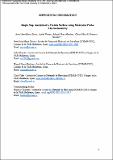Por favor, use este identificador para citar o enlazar a este item:
http://hdl.handle.net/10261/341088COMPARTIR / EXPORTAR:
 SHARE SHARE
 CORE
BASE CORE
BASE
|
|
| Visualizar otros formatos: MARC | Dublin Core | RDF | ORE | MODS | METS | DIDL | DATACITE | |

| Título: | Single stop analysis of a protein surface using molecular probe electrochemistry |
Autor: | Xavier, Jewel Ann Maria; Fuentes Sempere, Isabel; Nuez Martínez, Miquel; Viñas, Clara CSIC ORCID; Teixidor, Francesc CSIC ORCID | Palabras clave: | Hofmeister series Metallacarboranes |
Fecha de publicación: | 13-sep-2023 | Editor: | Royal Society of Chemistry (UK) | Citación: | Journal of Materials Chemistry B 11(35): 8422-8432 (2023) | Resumen: | Visualization of a protein in its native form and environment without any interference has always been a challenging task. Contrary to the assumption that protein surfaces are smooth, they are in fact highly irregular with undulating surfaces. Hence, in this study, we have tackled this ambiguous nature of the 'surface' of a protein by considering the 'effective' protein surface (EPS) with respect to its interaction with the geometrically well-defined and structurally inert anionic molecule [3,3'-Co(1,2-C2B9H11)2]-, abbreviated as [o-COSAN]-, whose stability, propensity for amine residues, and self-assembling abilities are well reported. This study demonstrates the intricacies of protein surfaces exploiting simple electrochemical measurements using a 'small molecule' redox-active probe. This technique offers the advantage of not utilizing any harsh experimental conditions that could alter the native structure of the protein and hence the protein integrity is retained. Identification of the amino acid residues which are most involved in the interactions with [3,3'-Co(1,2-C2B9H11)2]- and how a protein's environment affects these interactions can help in gaining insights into how to modify proteins to optimize their interactions particularly in the fields of drug design and biotechnology. In this research, we have demonstrated that [3,3'-Co(1,2-C2B9H11)2]- anionic small molecules are excellent candidates for studying and visualizing protein surfaces in their natural environment and allow proteins to be classified according to the surface composition, which imparts their properties. [3,3'-Co(1,2-C2B9H11)2]- 'viewed' each protein surface differently and hence has the potential to act as a simple and easy to handle cantilever for measuring and picturing protein surfaces. | Versión del editor: | http://doi.org/10.1039/d3tb00816a | URI: | http://hdl.handle.net/10261/341088 | DOI: | 10.1039/d3tb00816a | ISSN: | 2050-750X |
| Aparece en las colecciones: | (ICMAB) Artículos |
Ficheros en este ítem:
| Fichero | Descripción | Tamaño | Formato | |
|---|---|---|---|---|
| Xabier_JMatChemB_2023_editorial.pdf | Artículo principal | 1,68 MB | Adobe PDF |  Visualizar/Abrir |
| Xabier_JMatChemB_2023_suppl_editorial.pdf | Información complementaria | 1,89 MB | Adobe PDF |  Visualizar/Abrir |
CORE Recommender
Page view(s)
18
checked on 15-may-2024
Download(s)
19
checked on 15-may-2024
Google ScholarTM
Check
Altmetric
Altmetric
Este item está licenciado bajo una Licencia Creative Commons

